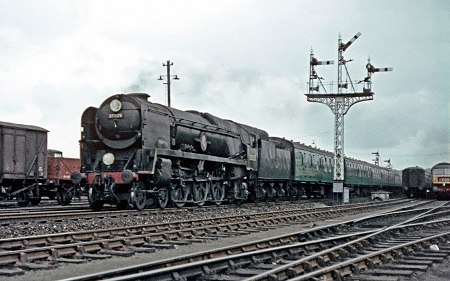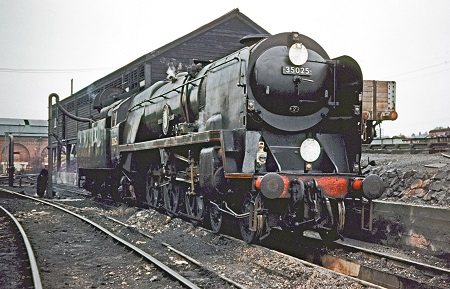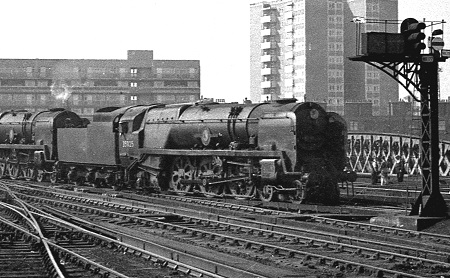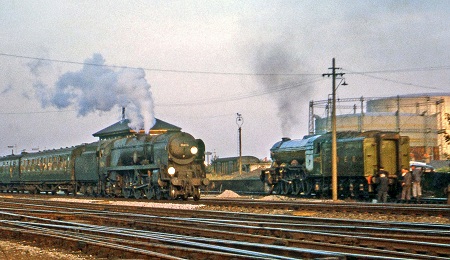35025 Brocklebank Line – BR Service
35025 Brocklebank Line was built at Eastleigh Works, entering service in November 1948. It was named on 20th September 1949. It was rebuilt in December 1956 and withdrawn in September 1964, after less than 16 years of service, the shortest period of service for any Merchant Navy. Its total mileage was 884,081, which was not the lowest of the class, with eight others completing even lower totals.
 |
35025 Brocklebank Line is about to pass a BR 12-ton ventilated van at Salisbury on Friday 10 April 1964. A class 47 diesel is on an Exeter train 1V08. V indicated a Western Region destination because at that time the Southern Region ended at Wilton. Photo: Terence Dorrity |
Construction
35025 was constructed at Eastleigh Works as part of order 3393 and entered traffic on the 27th November 1948, being allocated new to Bournemouth. It was fitted with boiler 1115 and attached to 6,000 gallon tender number 3343.
Liveries
35025 and initially ran unnamed in lined malachite green, possibly with British Railways on the tender similar to 35023. It was repainted in BR Express Passenger Blue during a works visit in September 1949 prior to the naming ceremony at Waterloo Station on the 20th September 1949 by Colonel D. H. Bates, Chairman of the shipping company.
Allocations
New to Bournemouth 11/48; 73A Stewarts Lane 25/3/50; 72A Exmouth Junction 19/3/52; 70A Nine Elms 22/6/54; 71B Bournemouth 5/6/56; 72A Exmouth Junction 10/3/60; 83D Western Region Stock 1/1/63
Withdrawn September 1964; Stored Exmouth Junction shed 2/65; Sold to Woodham Brothers, Barry 3/65
Boilers
Boilers were routinely switched between locos during overhauls as it took longer to repair a boiler than the rest of the loco, and use of spare boilers allowed faster turnround.
Boiler 1115 11/48 New; Boiler 1110 11/50; Boiler 1104 12/56
 |
35025 Brocklebank Line takes on water in front of the coaling stage at Salisbury shed (72B) on Sunday 4 June 1961. From the book "Way Down South: Southern Steam in the Sixties". Terence Dorrity. Published by Irwell Press. |
Timeline
35025 was one of the final batch of ten Merchant Navy Class locomotives built at Eastleigh Works for British Railways. Emerging from the works in November 1948 it entered service allocated to Bournemouth shed. Its livery from new was the Southern Railway style Malachite Green but with the BR number 35025. This allocation meant its work was chiefly along the South Western Main Line between Weymouth and London Waterloo. 35025 was officially named Brocklebank Line at Waterloo station by Colonel D.H. Bates, the Chairman of Brocklebank Line Shipping Company, on 20th September 1949. Just before its naming ceremony Brocklebank Line had been painted into BR Express Passenger Blue livery.
After a spell at Bournemouth the last six Merchant Navies, including 35025, were transferred to the Eastern Section. 35028/29/30 were allocated to Dover on 29th October 1949 with their principal duty being the Night Ferry service with its distinctive blue Wagon-Lits continental coaches. Five months later 35025/26/27 were allocated to Stewarts Lane on 25th March 1950 for Boat Train duties. The allocation of three Merchant Navies to Dover was found to be excessive so 35028 was moved to Stewarts Lane to join them.
35025 received boiler 1110 during a works visit in November 1950. It was found that the Light Pacifics could handle most of the traffic on the Eastern section and the Merchant Navies were under utilised, and so after almost two years 35025 Brocklebank Line was the first to return to the Western section, being allocated to 72A Exmouth Junction on 19th March 1952 whilst at Eastleigh works. It was painted in BR Green in June 1952 and Tender 3343 was swapped at this point so it could be converted with coal and self weighing equipment, and replaced by 6,000 gallon tender 3350 which would remain with Brocklebank Line for the rest of its BR life.
While based at Exmouth Junction 35025 worked the West of England Mainline up to Salisbury. Merchant Navy's were too heavy to work on the 'Withered Arm' lines north and west of Exeter. During its stint in Devon 35025 was recorded hauling the 'Atlantic Coast Express', the Southern Region's premier holiday express. Along with all the other Merchant Navies 35025 was temporarily withdrawn for thorough safety inspection in Spring 1953. These withdrawals were prompted after an axle on 35020 Bibby Line fractured while at speed on an express at Crewkerne.
The as-yet uncrowned Queen used the Royal Train on a visit to Devon from 1st - 3rd July 1952. The train returned from Exeter to Waterloo hauled by 35025. More troubling, 35025 suffered a connecting rod failure at Honiton on 10th December 1954, causing serious damage to the loco, coaches and track. Oil leaked on to the track and the loco caught fire, requiring to local fire brigade to attend the scene.
Some Merchant Navies enjoyed long associations with particular sheds, however 35025 was one that moved about a bit and after two years at Exmouth Junction it was reallocated to Nine Elms on the 22nd June 1954. Here, 35025 was used on both the South-Western and West of England main lines. In December 1954, 35025 suffered a major oil bath fire. This was serious enough to require main works attention at Eastleigh, it was reported that a broken inner rod caused the oil bath to fracture and start the fire. This exemplifies how hard the Merchants were worked especially on the West of England line where they were often pushed to the limit hauling 12-14 coaches. Almost two years later it moved again, returning to Bournemouth on the 5th June 1956.
1956 saw the Merchant Navies enter a rebuilding programme. This programme was designed to simplify maintenance and ease some of the problems with the original valve gear. As part of the rebuild the Merchants lost their distinctive air-smoothed casing and gained Walschaerts valve gear in place of the chain driven equipment. Brocklebank Line was rebuilt at Eastleigh. Boiler 1104 was also fitted at that time, and the nameplates had a black background. It emerged in December 1956 and returning to Bournemouth soon after. During this period 35025 was one of the go-to locomotives for the Bournemouth Belle Pullman service.
In July 1957 following non-classified repairs, Brocklebank Line was sent to Swindon to investigate a "knock" that had developed after running 35,000 miles, which led to revised settings for the inside and outside valve heads. The markings for the valve settings from this investigation are still present on 35025's slide bars.
 |
35025 and another Merchant Navy leaving Waterloo for Nine Elms. Photo: A very young Nick Thompson |
35025 received a further General Overhaul from 17th January to 10th March 1962, where the nameplates were grounded in the more popular red and the tender received the second, later "Ferret and Dart board" emblem. 35025 made its last move on 10th March 1960, back to Exmouth Junction for a second stint, effectively being swapped with 35023 which went to Bournemouth. With through engine working and crew changing at Salisbury firmly established in 1952, by 1958 Exmouth Junction regularly maintained an allocation of seven Merchant Navies principally for London express work.
These top link duties included the Up "Atlantic Coast Express", which was accelerated to a 60 mph "mile a minute" schedule in August 1961, while the diagrams often included balancing turns with Merchant Navies returning late at night from London with empty milk tanks. During this period 35025 would have rubbed shoulders with SLL favourite and fellow Exmouth Junction resident 34070 Manston. From 1963, the Southern line west of Salisbury (and the associated locomotives and rolling stock) were transferred to the Western Region. 35025 was listed as a Western Region locomotive though in reality, its duties were as before until Western Region Class 42 "Warship" Diesel Hydraulics became increasingly used on the Up Atlantic Coast Express, and slowly Bulleid Pacifics were transferred away from Exmouth Junction shed. 35022 and 35026 left for Nine Elms in March 1964, followed by 35003 in July while future preserved light Pacifics 34072 257 Squadron and 34081 92 Squadron also escaped to Eastleigh that summer
The last "Atlantic Coast Express" ran on Saturday 5th September 1964 and with the end of the summer timetable steam working was eliminated west of Salisbury. 35010 and 35013 were shipped out to Bournemouth at the last minute, leaving 15 Bulleid Pacifics dumped out of service at Exmouth Junction, which included 35025 Brocklebank Line possibly because it had been had been 2&1/2 years since its last General Overhaul and would have been approaching a Heavy Intermediate repair
 |
35025 leaving Basingstoke on 12th September 1964, passing 4472 Flying Scotsman which was waiting to return to London on the 'Farnborough Flyer'. Photo: David Christie |
A dozen light Pacifics, including three rebuilts were sold to Birds, and were cut up quickly at either Bridgend, Bynea or Morriston Swansea. 35001 Channel Packet was withdrawn from Bournemouth in November 1964 and followed them in February 1965. The two remaining Merchant Navies, 35009 Shaw Savill and 35025 Brocklebank Line became fifth and sixth Merchant Navies to be withdrawn, and along with light Pacific 34070 Manston were fortunate enough to be sold to Woodhams Brothers scrapyard in Barry. Two Bulleid Pacifics, rebuilt 34045 Ottery St. Mary and original 34094 Mortehoe, were actually cut up at Woodhams, but fortunate turns of event resulted in 28 other Bulleid Pacifics surviving to join 34023, 34051 and 35028 in preservation.
In 16 years of BR service, 35025 completed 884,081 miles with 420,041 of those completed in rebuilt condition.
References
Bulleid Power - The Merchant Navy Class" by A. J. Fry, Alan Sutton Publishing Ltd 1990.
The book of the Merchant Navy Pacifics" by Richard Derry, Irwell Press. 2001
Locomotives in Detail Vol. 1 - Bulleid 4-6-2 Merchant Navy Class" R. J. Harvey, Ian Allen Publishing Ltd. 2004
Portrait of the Atlantic Coast Express" Stephen Austin, Ian Allen Publishing Ltd. 1997
The Southern Pacifics by Roger J Mannion. 1998, Sutton Publishing Ltd., ISBN 0 7509 1734 2
